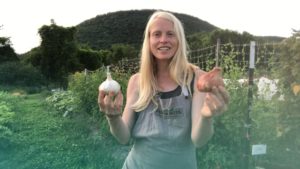We love to share what we love... and we love garlic and shallots! You'll find gorgeous seed garlic & shallots listed here every late Summer/early Fall. And don't forget the fertility... our Organic Garlic and Shallot Fertilizer has specially blended diverse amendments to feed both our soil and our alliums, and in turn, us!
Transcript: Garlic and shallots, two of the most heavy feeding crops you can grow in your garden. And yes, there’s a direct relationship between the quality and quantity of fertility they receive, nutrients they receive, and the quality and quantity of bulbs you will harvest. So I wanted to share a bit about this because, you know, I love our fish emulsion, and we spray it every week, 10 days, tops on our farm in the spring. But, we stop, we stop at third, fourth week in June, at the end of June certainly cut us off, because here’s the thing: if you are continuing to feed your garlic, your shallots, as they’re beginning to dry down and become dormant, they won’t. They will eventually, but it will take them longer. And that dormancy will be more green growth. And they’ll have to dry it down that much faster to actually be able to cure effectively.
So we stopped feeding our garlic and shallots about a month before we harvest. And of course, depending on the season, it’s hard to say exactly when you’re going to harvest them. Here on our farm, Fruition Seeds, in the Finger Lakes and zone five, we harvest our garlic and shallots anywhere from the middle of June, to the end of July. So definitely, like third weekend of June, we cut ourselves off and we stop feeding fish emulsion. And that way, they can learn that much more confident that our garlic and shallots will be curing that much more effectively. So as a general rule, you want to keep feeding everything in your garden, right up until like it’s getting really cold and then they’re not growing anymore. Frost is imminent. That way, they’re optimally full of nutrition. And I know it’s when I get sick is when I’m stressed and not eating well. So the same is true with our plants. So you want to give them as happy life and abundant of nutrients as you possibly can- fish emulsion to the rescue.
But when it comes to these crops like onions and garlic and shallots, you really want to hold back and cut them off from that abundant fertility. As soon as you start to see those leaves turning a little bit yellow, turning a little bit brown. And at that , third, fourth week in June, cut yourself off. So yes, if the leaves are turning a little yellow in May, that’s totally understandable and to be expected, but as soon as it looks like it’s a little different, like it’s really going systemic going deep into the plant and it’s a third week in June — cut yourself off so they can go into their dormancy.
This is our Dutch Red Shallot, by the way, they are so huge and so delicious and so productive. They were like five of these on one plant is an impressively abundant plant and this is our Italy Hill Garlic. It’s a marvelous porcelain that’s been grown here in the Finger Lakes for the better part of a century. So it’s my favorite perk for pesto this year. But yeah, this is Petra, signing off. I love you, and I hope that you have the most abundant season and now you know, cut yourself off at the end of June when it comes to fertility with your shallots and garlic.


